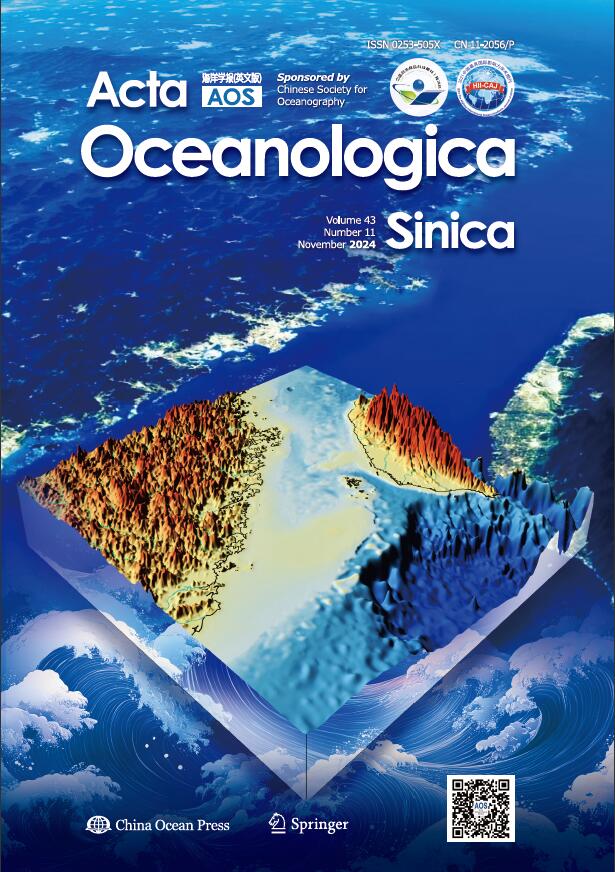2008 Vol. 27, No. 5
Display Method:
2008, (5): 1-20.
Abstract:
Synoptic features in/around thermal fronts and cross-frontal heat fluxes in the southern Huanghai/Yellow Sea and East China Sea (HES) were examined using the data collected from four airborne expendable bathythermograph surveys with horizontal approx...
Synoptic features in/around thermal fronts and cross-frontal heat fluxes in the southern Huanghai/Yellow Sea and East China Sea (HES) were examined using the data collected from four airborne expendable bathythermograph surveys with horizontal approx...
2008, (5): 21-35.
Abstract:
Seasonal, interannual and interdecadal variations of monsoon over the South China Sea (SCS) directly influence the ocean circulation and the mass transport process, etc., especially the changes of horizontal circulation pattern and upwelling area. Th...
Seasonal, interannual and interdecadal variations of monsoon over the South China Sea (SCS) directly influence the ocean circulation and the mass transport process, etc., especially the changes of horizontal circulation pattern and upwelling area. Th...
2008, (5): 36-48.
Abstract:
A new model developed from the full-spectrum model of Lyzenga and Bennett (1988) is built up by us preliminarily through considering the impact of the ocean surface mixed layer turbulence on SAR remote sensing of internal solitary waves. In the parti...
A new model developed from the full-spectrum model of Lyzenga and Bennett (1988) is built up by us preliminarily through considering the impact of the ocean surface mixed layer turbulence on SAR remote sensing of internal solitary waves. In the parti...
2008, (5): 49-62.
Abstract:
Altimetry data have been widely used in various fields of oceanography, including the extreme weather events such as tropical cyclones, typhoons, and hurricanes. The performance of JASON1 in Typhoon Shanshan is assessed by examining the sensor geophy...
Altimetry data have been widely used in various fields of oceanography, including the extreme weather events such as tropical cyclones, typhoons, and hurricanes. The performance of JASON1 in Typhoon Shanshan is assessed by examining the sensor geophy...
2008, (5): 63-80.
Abstract:
With the tides propagating from the open sea to the lagoon, the mean water level (MWL) in the inlet and lagoon becomes different from that at the open sea, and a setup/setdown is generated. The change of MWL (setup/setdown) in the system imposes a gr...
With the tides propagating from the open sea to the lagoon, the mean water level (MWL) in the inlet and lagoon becomes different from that at the open sea, and a setup/setdown is generated. The change of MWL (setup/setdown) in the system imposes a gr...
2008, (5): 81-97.
Abstract:
Over the past four periods (1959-1960, 1982-1983, 1992-1993, and 1998-1999), the ecosystem of the Bohai Sea changed due to both a significant decrease of river water discharge from the Huanghe River and a reduction of precipitation. The shifts in nut...
Over the past four periods (1959-1960, 1982-1983, 1992-1993, and 1998-1999), the ecosystem of the Bohai Sea changed due to both a significant decrease of river water discharge from the Huanghe River and a reduction of precipitation. The shifts in nut...
2008, (5): 98-110.
Abstract:
A nitrogen and phosphorus dynamic model of mesocosm pelagic ecosystem was established according to the summary and synthesis of the models available, in which seven state variables (DIN, PO4-P, DON, DOP, phytoplankton, zooplankton and detritus) were ...
A nitrogen and phosphorus dynamic model of mesocosm pelagic ecosystem was established according to the summary and synthesis of the models available, in which seven state variables (DIN, PO4-P, DON, DOP, phytoplankton, zooplankton and detritus) were ...
2008, (5): 111-125.
Abstract:
Four cruises were conducted during 2002-2003 in the Changjiang Estuary and adjacent coastal areas. The data presented show a clear coast to open sea gradient in nutrients related to the river inputs. Maximum values of chlorophyll a were typically obs...
Four cruises were conducted during 2002-2003 in the Changjiang Estuary and adjacent coastal areas. The data presented show a clear coast to open sea gradient in nutrients related to the river inputs. Maximum values of chlorophyll a were typically obs...
2008, (5): 126-133.
Abstract:
One adult α-globin gene and one β-globin gene have been cloned from the large yellow croaker Pseudosciaena crocea. Linkage analysis indicated that the αand β-globin genes were oriented head-to-head relative to each other. To identify the regulatory e...
One adult α-globin gene and one β-globin gene have been cloned from the large yellow croaker Pseudosciaena crocea. Linkage analysis indicated that the αand β-globin genes were oriented head-to-head relative to each other. To identify the regulatory e...
2008, (5): 134-146.
Abstract:
The identification of scallop larvae is essential to understand the population structure and community dynamics and to assess the potential environmental impacts caused by scallop larvae released or escaped. However, the larvae identification by morp...
The identification of scallop larvae is essential to understand the population structure and community dynamics and to assess the potential environmental impacts caused by scallop larvae released or escaped. However, the larvae identification by morp...
2008, (5): 147-162.
Abstract:
Phytoplankton group-specific growth and microzooplankton grazing were determined seasonally using the dilution technique with high-performance liquid chromatography (HPLC) in the Xiamen Bay, a subtropical bay in southeast China, between May 2003 and ...
Phytoplankton group-specific growth and microzooplankton grazing were determined seasonally using the dilution technique with high-performance liquid chromatography (HPLC) in the Xiamen Bay, a subtropical bay in southeast China, between May 2003 and ...














